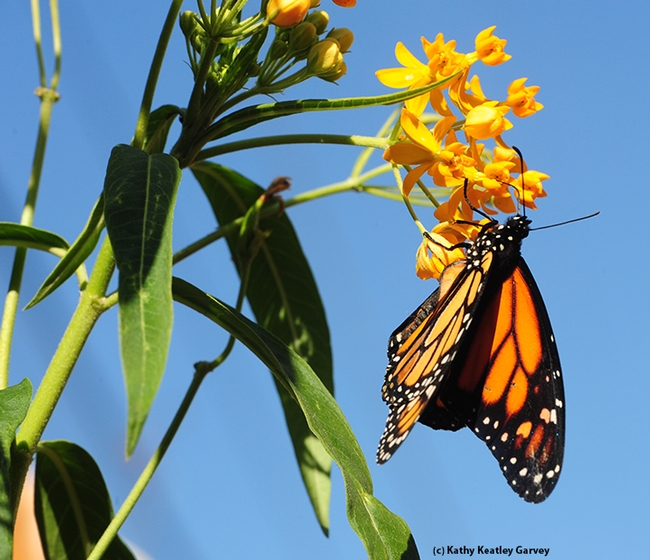Counting butterflies before they eclose from their chrysalids is sort of like counting chickens before they hatch.
We've done both: raised chickens and reared butterflies.
Fact is, you never know if a butterfly will eclose. The old adage of "Don't count your chickens before they hatch" rings true, as does "Don't count your butterflies before they eclose."
We've reared and released a total of 20 monarch butterflies this year in Vacaville, Calif. It's a small conservation effort, true, but what a difference it's made for those 20 monarchs! Now three chrysalids remain. Unlike the others, all three chrysalids are outdoor chrysalids. Two are hanging in an aquarium setting and look viable. One is tucked inside a zippered mesh laundry hamper and shows no sign of life or pending life.
The "no-sign-of-life" chrysalis turned from jade green to black on Nov. 15. Aha, we thought. We'll get a butterfly within 48 hours. That was the case with our indoor chrysalids once they darkened. (Note that a chrysalis looks like a gold-studded green jewel for about 10 days before it darkens. Then the monarch ecloses and hangs onto the transparent pupal case until it unfolds and dries its wings.)
This time nothing happened. We could clearly see the wing pigment. Hello, you in there! Time's up! Are you coming out or what?
Hmm, we thought. Maybe this is a "what." Cold weather delaying the eclosure? The "P" word--parasitized? The "D" word--diseased or dead?
So we contacted butterfly guru Art Shapiro, distinguished professor of evolution and ecology at the University of California, Davis. He's been monitoring butterfly populations in central California for more than 40 decades (see his website). He's the author of Field Guide to Butterflies of the San Francisco Bay and Sacramento Valley Regions (California Natural History Guides), a book, by the way, that's available in the Bohart Museum of Entomology gift shop on campus as well online.
It's not parasitized, he said, or it would not have developed the wing pigment.
Then Shapiro's keen eyes detected this: "On the dorsal surface there is a kink in the integument and there is a lot of intersegmental membrane showing. I think your beast developed to the pharate adult and died uneclosed--three weeks ago."
He recommends we keep it hanging for a few more days to see what happens. "The integument should fall off and you can inspect the pharate cadaver!"
Well, let's see. One down and two to go and then it's all over until next year.
Oh, wait, don't count your monarchs before they eclose...
Attached Images:

This monarch chrysalis, hanging outdoors in a hamper, is apparently not viable. It turned from jade green to back on Nov. 15. (Photo by Kathy Keatley Garvey)

An earlier success in monarch rearing. (Photo by Kathy Keatley Garvey)

A newly released monarch on a milkweed. (Photo by Kathy Keatley Garvey)